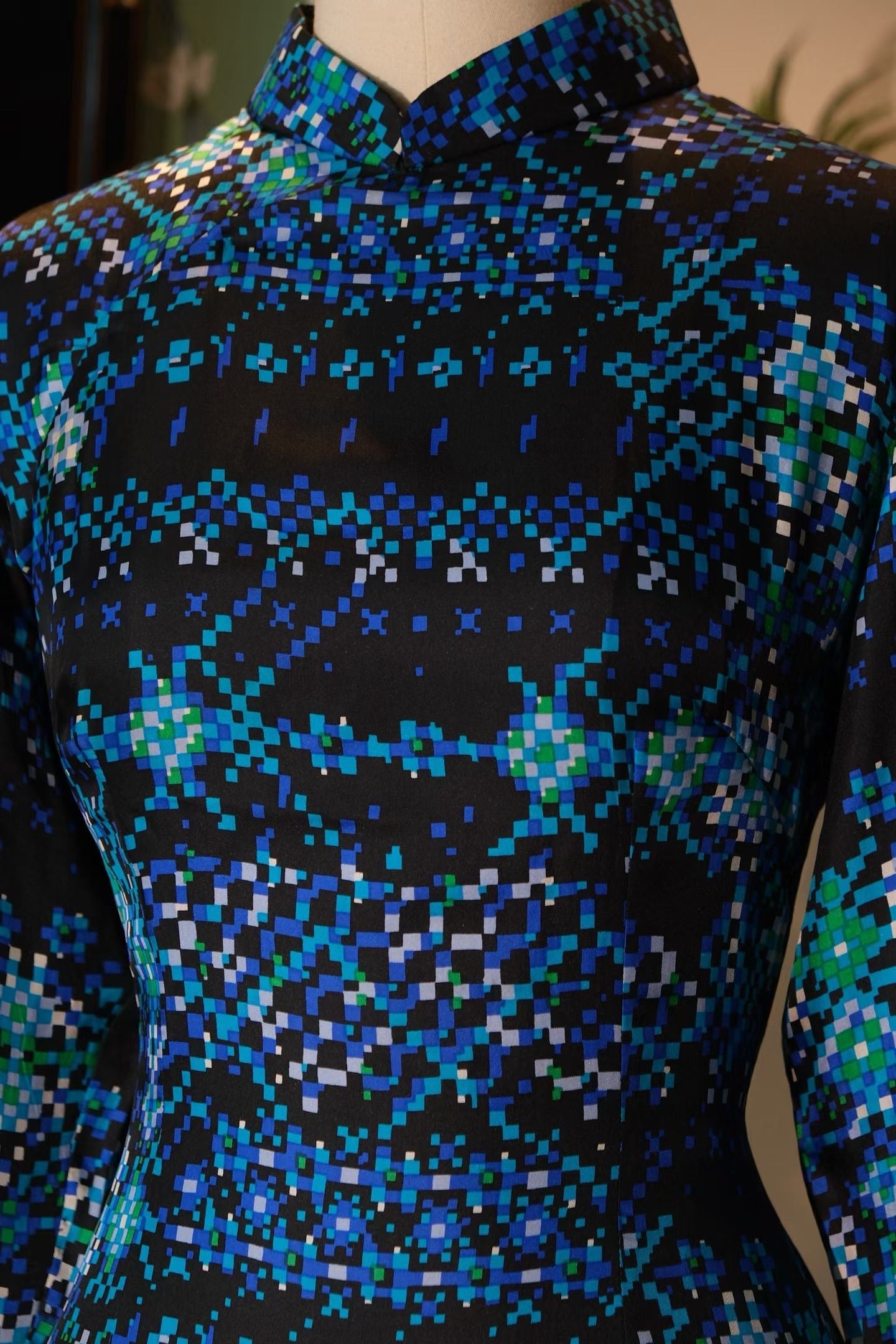深圳溯源
60年代 - 「赛博浮光」:一九六零年代像素美学欧普几何古董港式旗袍 / 1960s - "Cyber Luminance": A 1960s Hong Kong Vintage Qipao with Pixel Art Aesthetics and Op Art Geometric Motifs
60年代 - 「赛博浮光」:一九六零年代像素美学欧普几何古董港式旗袍 / 1960s - "Cyber Luminance": A 1960s Hong Kong Vintage Qipao with Pixel Art Aesthetics and Op Art Geometric Motifs
无法加载取货服务可用情况
分享一件上世纪六十年代赛博浮光像素美学香港产古董旗袍。
这件诞生于1960年代的香港古董旗袍,以黑底为幕,
1960年代,香港作为“东西方流行文化的转口港”,
这件旗袍,是香港作为“东方摩登橱窗”的时代见证者:
"Cyber Luminance": Pixel Magic, Op Art Geometry, and a Hong Kong Qipao Woven with the Future
We share a highly rare 1960s vintage Qipao from Hong Kong that channels the aesthetic of "Cyber Luminance" and pixel art. Born in the 1960s, this garment uses a black ground as its backdrop to deconstruct traditional auspicious motifs into a "Pixel Magic Cube" of blue, green, and white, reconstructing Oriental aesthetics in a minute space.
In the main pattern, intertwining floral vines sprawl as a point-matrix system. The round floral motif at the neckline is composed of stacked pixel squares that form a radial halo, as if the traditional image of "Auspicious Clouds supporting the Sun" from ancient texts has been deconstructed by modern graphics. Along the piping of the collar and sleeves, the traditional "Wan-Zi Everlasting Knot" motif is subtly hinted at—a symbol of prosperity originating from the Shang-Zhou era huiwen (meander patterns) and popular in the Ming and Qing dynasties. Here, it is pixelated into a repeating sequence of squares, using a modern visual language to subvert the luxurious narrative of traditional brocade.
In the 1960s, Hong Kong, as a "transit port for East-West popular culture," was experiencing a fierce clash between traditional Qipao styles and Western avant-garde art. The design language of this piece perfectly aligns with the global trend of Op Art (Optical Art)—which uses the regular arrangement of geometric shapes to create visual vibration. The tessellation of pixel squares generates a "Cyberpunk-esque" flow of light and shadow under illumination, perfectly illustrating scholar Chen Guanzhong's assertion: "The essence of Hong Kong design lies in grafting the most international styles onto the most local genes." At the time, the Liangyou Pictorial recorded the innovations of Hong Kong Qipao manufacturers: "Those using traditional Chinese motifs as the framework, but adorned with gold and diamonds, are the 'Old Modern.' Those featuring geometric deconstruction are the 'New Modern.'"
This Qipao is a definitive example of the "New Modern." It rejects the realism of traditional printing, maintains the core of Chinese auspicious culture, and simultaneously uses a modern graphic language to reflect the prevailing spirit of the age—the Apollo moon landing and the popularization of the electronic computer. It is a precious specimen of the "Modernization of Oriental Aesthetics."
This Qipao is a contemporary witness to Hong Kong as the "Showcase of Oriental Modernity." It uses pixel squares as ink, writing a dialogue between "The Ancient Orient and the Future World" on the black satin, resurrecting the "genetic code" of traditional motifs within modern graphics. Viewed today, it is not merely a vintage garment but a "walking scroll of Pixel Art History," holding the echoes of the 1960s global cultural clash—when Hong Kong designers were using geometric magic cubes in miniature to open the door of Oriental aesthetics to the future.
分享






